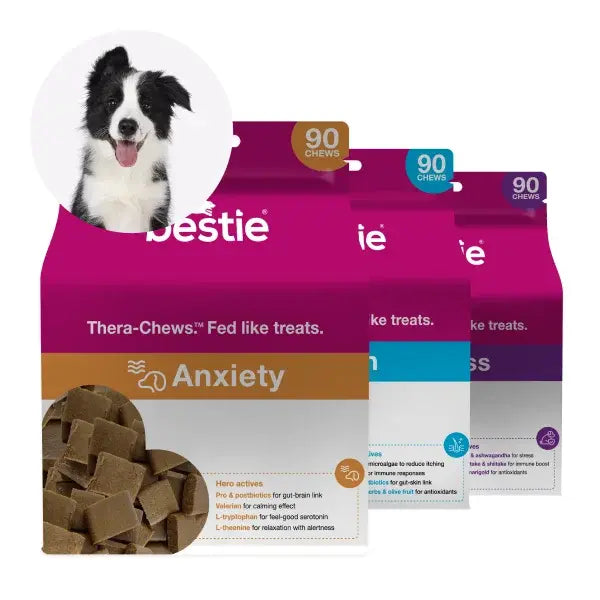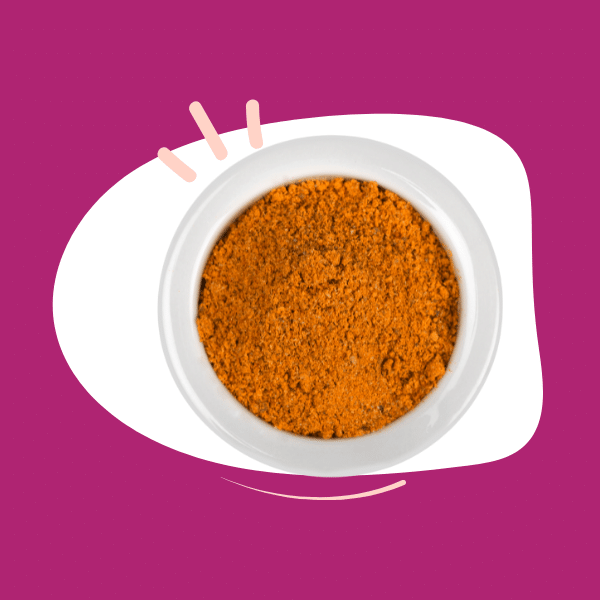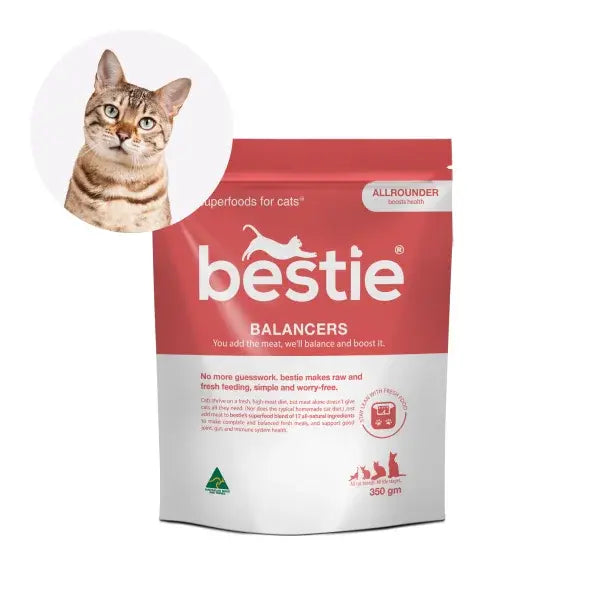Hemp oil is touted as the best thing since sliced bread for your dogs and cats, because it's rich in omega-6 and omega-3 fatty acids in a perfect ratio of 3:1... But is that really true?
Read on to discover what fatty acids your dog really needs, why all fatty acids aren't equal, and the best sources...
By the way, we include a great source of specific fatty acids (EPA and DHA which we'll explain in a minute) via our cod liver oil in our bestie Allrounder balancer pre-mix. We also include hempseed meal and hemp oil in some instances.
In a nutshell:
- Specific fatty acids are essential components in the diet of dogs and cats. In fact, they’re included in the National Research Council (NRC) and the Association of American Feed Control Officials (AAFCO) nutrient recommendations for pet food.
- There are several types of fatty acids. Essential fatty acids (EFAs), like eicosapentaenoic acid (EPA), and docosahexaenoic acid (DHA), are not produced in adequate amounts in the body, which makes it necessary to supplement your pet’s diet with viable sources of these particular EFAs.
- Non-essential fatty acids can be produced in the body. They may or may not be supplied in the diet.
What are fatty acids?
Dietary fatty acids, also called “lipids”, is a class of nutrients that include fats, oils, phospholipids, cholesterol, and fatty acids. They can be classified based on the number of double bonds they contain.
- Saturated fats (SFA) don’t have any double bonds
- Monounsaturated fats (MUFA) have one double bond
- Polyunsaturated fats (PUFA) have two or more double bonds. These are the omega fatty acids, specifically, omega-3, omega-6, and omega-9, which are all long-chain fatty acids.
Polyunsaturated fats are classified as “essential fatty acids” (EFAs). These can be synthesized in the body but only in very limited amounts, thus they need to be included in the daily diet of pets to prevent signs of deficiency. The most popular essential fatty acids are omega-6 and omega-3 fatty acids.
Types of omega-3 fatty acids
There are three types of omega-3 fatty acids. These are alpha-lipoic acid (ALA), eicosapentaenoic acid (EPA), and docosahexaenoic acid (DHA). For dogs, the most beneficial omega-3 fatty acids are DHA and EPA.
Types of omega-6 fatty acids
As for the omega-6 fatty acids, linoleic acid is essential for both dogs and cats, while arachidonic acid is essential only for cats. Cats lack the enzyme that is required by the body to convert linoleic acid to arachidonic acid.
Table 1. Essential Fatty Acids For Dogs And Cats
|
Omega 3 |
Common Sources |
Omega 6 |
Common Sources |
|
Alpha-linolenic acid (ALA) |
Flax and chia seeds, green leafy vegetables, walnut, canola, and soybean oils |
Linoleic acid (LA) |
Plant-based oils (corn oil, flaxseed oil, safflower oil, soybean oil, canola oil) |
|
Eicosapentaenoic acid (EPA) |
Oily fish, krill oil, algae oil |
Arachidonic acid (AA) |
Meat, poultry, eggs |
|
Docosahexaenoic acid (DHA) |
Oily fish, krill oil, algae oil |
|
|
All omega-3 fatty acids aren't equal
Fish oil is a good source of EPA and DHA. Theoretically, EPA and DHA can be derived from another omega-3 fatty acid, ALA. However, ALA is not efficiently converted to EPA and DHA in mammals, including humans and dogs. Cats cannot make the conversion at all.1
The primary reason is the lack of an enzyme that can make the conversion possible. Therefore, when supplementing omega-3 fatty acids, fish oil is a more potent and efficient source of EPA and DHA as compared with products rich in ALA such as flaxseed, linseed, or canola oil.2
Why supplementing with EPA/DHA-rich fish oil can be good for your dog
Many commercial pet foods contain far more omega-6s than omega-3s, but it has been shown that diets higher in omega-3s can provide significant health benefits.8 Here are important reasons why your pet’s diet should be supplemented with essential fatty acids, particularly long-chain polyunsaturated fatty acids (PUFAs):
- Viable sources of energy
- Promote the absorption of fat-soluble vitamins A, D, E, and K
- Exert anti-inflammatory effects
- Promote immune system function
- Precursor of prostaglandins and eicosanoids
- Important component of cell membrane structure
- Promote healthy skin and haircoat
- Support growth and development
- Support reproduction and fertility
- Plays important roles in vision and nervous system function
Dietary requirements of essential fatty acids in the diet
Good quality pet foods contain adequate quantities of omega-3 and omega-6 fatty acids. However, too much or too little ofeither type of essential fatty acid can have adverse health effects. The minimum requirements recommended by AAFCO and NRC for different life stages of dogs and cats are listed in Table 2.
Table 2. Minimum Requirements of Essential Fatty Acids (grams/1000 kcal)
|
|
|
Dogs (Growth) |
Dogs (Adult Maintenance) |
Cats (Growth)
|
Cats (Adult Maintenance) |
|
Total Fat |
NRC |
21.3 |
13.8 |
22.5 |
22.5 |
|
AAFCO |
21.3 |
13.8 |
22.5 |
22.5 |
|
|
Linoleic Acid |
NRC |
3.3 |
2.8 |
1.4 |
1.4 |
|
AAFCO |
3.3 |
2.8 |
1.4 |
1.4 |
|
|
Arachidonic Acid |
NRC |
0.08 |
ND |
0.05 |
0.015 |
|
AAFCO |
ND |
ND |
0.05 |
0.05 |
|
|
Alpha-linolenic Acid |
NRC |
0.2 |
0.11 |
0.05 |
ND |
|
AAFCO |
0.2 |
ND |
0.05 |
ND |
|
|
Eicosapentainoic Acid + Docosa-hexaenoic Acid |
NRC |
0.13 |
0.11 |
0.025 |
0.025 |
|
AAFCO |
0.1 |
ND |
0.03 |
ND |
*ND = not determined
Source: Role of Dietary Fatty Acids in Dogs & Cats
Do commercial pet foods contain enough essential fatty acids?
Fatty acid composition in commercial dry dog foods, including contents of essential fatty acids (EFA), varies substantially. While some pet foods had almost little to no marine oils and specific omega-3 fatty acids, other diets have omega-3 fatty acids but are primarily in the form of plant-sourced alpha-linolenic acid (ALA). The differences in the omega-3 and omega-6 levels may also explain some of the varying biological responses of dogs to dog food.11
If the omega-3 fatty acids are supplied primarily as alpha-linolenic acid (ALA), for example from hemp seed oil, the health benefits that come from EPA and DHA will not be provided by that pet food.
A 2020 study compared the fat content reported on the labels of 10 dry dog foods with laboratory-measured profiles of omega-3 fatty acids, DHA and EPA from the foods. While all pet foods in the study included the levels of total omega-6 and total omega-3 fatty-acids, and five included EPA and DHA content on their product labels, the results of the laboratory analysis told a different tale:
“The labeling information on the EPA and DHA concentrations are not in accordance with the results obtained by gas chromatography (GC) with flame ionisation detector (FID) nor by electrospray ionisation mass spectrometry (ESI-MS). This means that the information displayed on the labels are in disagreement with the results obtained for the fatty acid composition analysis by GC-FID and for the lipid profile analysis by ESI(+)-MS.”12
How much fish oil should be given to dogs and cats?
The Association of American Feed Control Officials’ (AAFCO) recommendations for EPA and DHA allowances and upper limits in pets:3
- For canine growth and reproduction diets: 10 mg/100 kcal or 0.05% dry matter basis
- For feline growth and reproduction diets: 3 mg/100 kcal or 0.012%
- For adult canine and feline maintenance diets: no minimum EPA or DHA requirements
- Safe upper limit of omega 6:omega 3 fatty acids in dog food is 30:1
The National Research Councils’ (NRC) recommendation for the safe upper limit for puppies, adult dogs, and reproducing dogs, specifically for total EPA and DHA content, is 280 mg/100 kcal (2.8g EPA +DHA PER 1000 kcal).
No safe upper limit has been published for cats at any life stage.4
Table 3. Symptoms of Essential Fatty Acid Deficiency
|
Omega-6 Fatty Acid Deficiency |
Omega-3 Fatty Acid Deficiency |
|
Skin and hair coat problems Reproductive issues Failure to thrive |
Neurologic abnormalities Dermatologic disease |
What happens when there is too much fatty acids in the diet of dogs and cats?
Like all drugs and dietary supplements, there is a potential for adverse effects with the usage of omega-3 fatty acids, especially when diets are supplemented with them or when they are present in diets in large amounts.2
Potential adverse effects associated with the use of omega-3 fatty acids in pets include the following:2
- Altered platelet function, specifically decreased platelet aggregation in cats
- GI adverse effects (vomiting, diarrhea, pancreatitis)
- Altered wound healing, specifically decreased epithelialization of wounds after five days (dogs)
- Lipid peroxidation increased plasma and urine thiobarbituric reactive substances (dogs)
- Decreased plasma vitamin E in dogs
- Nutrient excess, toxin exposure, or both -- includes consumption of heavy metals, chemicals such as polychlorinated biphenyls, hypervitaminosis A and D
- Weight gain - obesity, weight gain, or failure to induce weight loss
- Altered immune function
- Effects on glycemic control and insulin sensitivity, specifically, improved glucose control and decreased serum insulin concentration [cats]
- Nutrient-drug interactions
Why hemp oil is not the best source of omega-3 and omega-6 fatty acids for your pet
There are several important reasons why hemp oil is not the best source of omega-3 and omega-6 fatty acids for pets.
The oil obtained from hempseed contains up to 90% of polyunsaturated fatty acids (PUFA) particularly linoleic acid (LA) and alpha-linolenic acid (ALA).5Theoretically, LA (omega-6) can be converted to arachidonic acid, and ALA (omega-3) and will be converted into the long chain fatty acids, eicosapentaenoic acid (EPA) and docosahexaenoic acid (DHA) in the body. The conversion is aided by the enzymes Δ6-desaturase, Δ5-desaturase, and elongases.
However, the conversion of ALA to EPA in dogs, is less efficient than providing dietary EPA.9 For DHA this effect is even more pronounced than for EPA, since the conversion rate is even lower.10
Dogs lack the enzymes that can convert LA and ALA into EPA and DHA, which means these plant-based polyunsaturated fatty acids in hemp oil won’t be efficiently utilized in the body. Therefore, if hemp oil is the main source of fatty acids for your pet, it can increase your pet’s risk for specific deficiencies that can be serious or even life-threatening in the long run.
In addition, hemp seed oil is considered healthy because of its desirable omega-6: omega-3 fatty acid ratio, 3:1.6 However, the ratio is lower than current recommendations for pets which is approximately 10:1 to 5:1.7
Hemp also contains a higher percentage of PUFA that could also limit the shelf-life of the food product or supplement because of increased peroxidation during the production process and storage.6
Other important considerations when giving fatty acids to pets
- A dog that’s on a fish oil supplement should not be given aspirin. Be sure to inform your veterinarian if your pet is taking regular fish oil supplements.
- When introducing a fish oil supplement to your dog, start by giving the minimum dose and gradually increase the amount daily until you are giving the recommended dose.
List of References:
- Heinze, Cailin R. The Skinny on Fat: Part 2 – Essential fatty acids and inflammation. April 02, 2018. Accessed: May 14, 2022
- Lenox, C. E. and J. E. Bauer. Potential Adverse Effects of Omega-3 Fatty Acids in Dogs and Cats. Journal of Veterinary Internal MedicineVolume 27, Issue 2 p. 217-226. https://doi.org/10.1111/jvim.12033
- Association of American Feed Control Officials. Model Regulations for Pet Food and Specialty; Pet Food Under the Model Bill. In: 2019 Official Publication. Champaign, IL; 2019:139-225.
- National Research Council. Nutrient requirements and dietary nutrient concentrations. Nutrient Requirements of Dogs and Cats. Washington, DC: The National Academies Press, 2006, pp 354-370.
- Rocca, G.D. and Alessandra Di Salvo.Hemp in Veterinary Medicine: From Feed to Drug.Front. Vet. Sci., 28 July 2020 | https://doi.org/10.3389/fvets.2020.00387
- Vastolo, A, Sergio Iliano, Flaviana Laperuta, Saverio Pennacchio, Marina Pompameo and Monica Isabella Cutrignelli. Hemp Seed Cake as a Novel Ingredient for Dog's Die Published online 2021 Dec 14. doi: 10.3389/fvets.2021.754625
- Dym, Michael. Recommended Omega-3 and Omega-6 Ratio for Pets. November 17, 2011. Date accessed: 01 June 2022.
- Kidd, Randy, DVM. Fatty Acids for Pet Skin and Haircoat Health. Accessed: June 10, 2022.
- Stoeckel K, Leif Højvang Nielsen, Herbert Fuhrmann, and Lisa Bachmann. Fatty acid patterns of dog erythrocyte membranes after feeding of a fish-oil based DHA-rich supplement with a base diet low in n-3 fatty acids versus a diet containing added n-3 fatty acids. Acta Vet Scand. 2011; 53(1): 57. doi: 10.1186/1751-0147-53-57.
- Dunbar BL, Bigley KE, Bauer JE. Early and Sustained Enrichment of Serum n-3 Long Chain Polyunsaturated Fatty Acids in Dogs Fed a Flaxseed Supplemented Die Lipids. 2010;45:1–10. doi: 10.1007/s11745-009-3364-9.
- Ahlstrøm, O. Åshild Krogdahl, Stine Gregersen Vhile, Anders Skrede. Fatty Acid Composition in Commercial Dog Foods. The Journal of Nutrition, Volume 134, Issue 8, August 2004, Pages 2145S–2147S, https://doi.org/10.1093/jn/134.8.2145S
- Roberta da Silveira, Patrícia D. S. dos SantosJessica S. PizzoNayane MattosMatheus C. de Castro. Evaluation of Dog Food Authenticity through Lipid Profile Using GC-FID and ESI-MS. Braz. Chem. Soc. 31 (12) • Dec 2020 • https://doi.org/10.21577/0103-5053.20200126
















